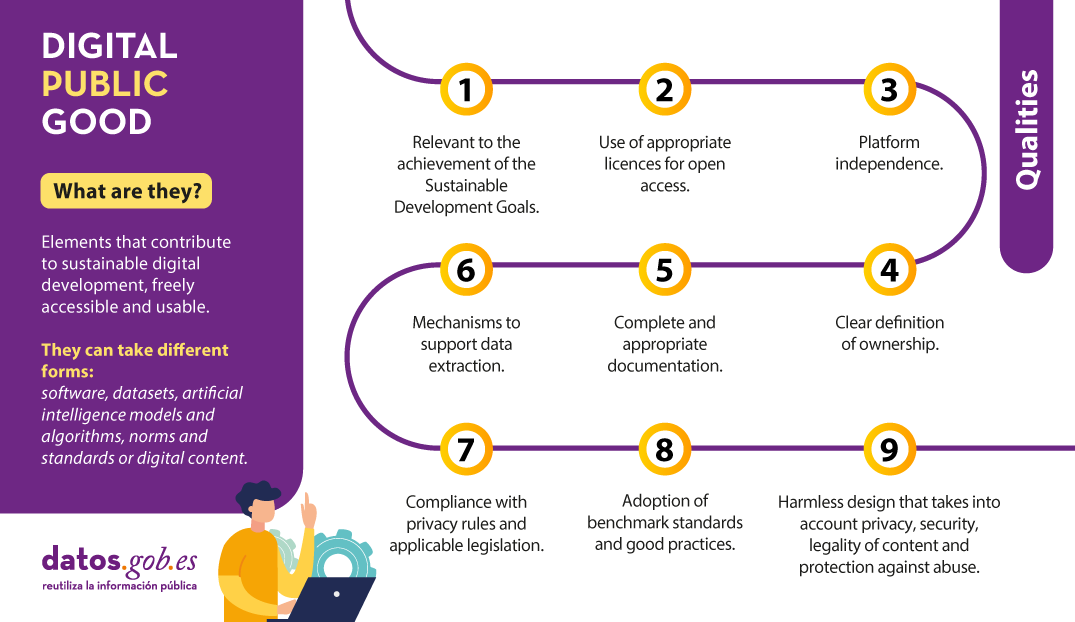
The Web emerged more than 30 years ago as an open, participatory and inclusive network that encouraged access to and reuse of knowledge through a spirit of collaboration and constant experimentation. This is precisely the same concept and philosophy that the government open data community adopted a few years after its birth.
Today we can observe how a new application of that same philosophy is gaining an increasing relevance, driven again by public administrations through digital public goods. This time the original principles of collaborative development, free access and reuse of open government data are expanded to other digital assets under the same criteria as a logical evolution.
What are public digital goods?
The concept of digital public goods is inspired by this same initial objective of the Web and the philosophy of various other movements such as open source, open data and open knowledge, extending it to any digital good of potential public interest - that is, those that, because of their potential to contribute to sustainable digital development, should be freely accessible and usable and that can be materialised in different formats, such as software, datasets, artificial intelligence models and algorithms, norms and standards, or a variety of digital content. Among their advantages are that they are scalable and adaptable, transparent, interoperable, minimise redundancy and fragmentation, enable cost savings, facilitate collaboration and foster innovation.
In short, it is about building a digital commons for all humanity that we can enjoy and manage in a coordinated and joint way for the good of society - just as we already do today with other elements of our analogue heritage such as the oceans, Antarctica or outer space.
The United Nations considers digital public goods in its roadmap for digital cooperation as an essential element in achieving the Sustainable Development Goals and, according to the World Economic Forum, they will also be key to tackling the world's major challenges. But this will require a coordinated global effort to enable, facilitate and promote the creation of these assets. In this respect, some prominent actions in this direction have become visible in recent years, such as the Digital Public Goods Alliance, the Digital Public Goods Charter, the AI Commons ecosystem or, in the specific field of data, the Global Data Access Framework (GDAF) - which aims to transform the discoverability of data by defining a global platform for data sharing together with several standard protocols for data exchange.
Digital public goods initiatives
A clear example of the work being carried out is the Digital Public Goods Standard (DPG Standard). This standard defines the nine qualities that a digital asset must meet in order to be considered a digital public good:
- Relevant to the achievement of the Sustainable Development Goals (SDGs).
- Use of appropriate licences for open access.
- Platform independence.
- Clear definition of ownership.
- Complete and appropriate documentation.
- Mechanisms to support data extraction.
- Compliance with privacy rules and applicable legislation.
- Adoption of benchmark standards and good practices.
- Harmless design that takes into account privacy, security, legality of content and protection against abuse.

In addition, there is a repository of public digital goods that is fed by contributions from all stakeholders and organised according to the development objective to which they can contribute. Thematic reports highlighting some of these digital public goods for their potential to address critical needs in specific sectors such as financial inclusion, health or climate change are also available.
According to the UN, all these new collaborative initiatives will also play a key role in further developing and evolving the necessary common standards and norms. This will also help guide both the public and private sectors on the best ways to facilitate access to their data and enable more data to become digital public goods, while respecting data privacy and confidentiality and significantly improving trust in technology. On the other hand, digital public goods are also valuable components for building countries' digital infrastructure in a reliable, secure and inclusive way - such as payment or identification systems - and thus enablers of digital sovereignty.
Finally, an interesting example of how all these concepts have also been applied in recent years by the European Commission is Joinup: the European Union's collaborative platform for the development of interoperable, open and free ICT solutions. Through this platform we can find multiple examples of a variety of public digital goods such as software solutions, standards or educational content.
Content prepared by Carlos Iglesias, Open data Researcher and consultant, World Wide Web Foundation.
The contents and views expressed in this publication are the sole responsibility of the author.